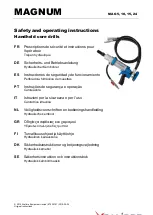
30
EnGLIsH
Chargers
D
e
WALT
chargers require no adjustment and are designed to be
as easy as possible to operate.
Electrical Safety
The electric motor has been designed for one voltage only.
Always check that the battery pack voltage corresponds to the
voltage on the rating plate. Also make sure that the voltage of
your charger corresponds to that of your mains.
i
Your
D
e
WALT
charger is double insulated in
accordance with EN60335; therefore no earth wire
is required.
Residual Risks
In spite of the application of the relevant safety regulations
and the implementation of safety devices, certain residual risks
cannot be avoided. These are:
• Impairment of hearing.
• Risk of personal injury due to flying particles.
• Risk of burns due to accessories becoming hot
during operation.
• Risk of personal injury due to prolonged use.
SAVE THESE INSTRUCTIONS
to bend if allowed to rotate freely without contacting the
workpiece, resulting in personal injury.
•
Always start drilling at low speed and with the bit tip
in contact with the workpiece.
At higher speeds, the bit is
likely to bend if allowed to rotate freely without contacting the
workpiece, resulting in personal injury.
•
Apply pressure only in direct line with the bit and do not
apply excessive pressure.
Bits can bend causing breakage or
loss of control, resulting in personal injury.
•
Use clamps or other practical way to secure and support
the workpiece to a stable platform.
Holding the work by
hand or against your body is unstable and may lead to loss
of control.
•
Wear ear protectors when hammering for extended
periods of time.
Prolonged exposure to high intensity noise
can cause hearing loss. Temporary hearing loss or serious ear
drum damage may result from high sound levels generated
by hammerdrilling.
•
Wear safety goggles or other eye protection.
Hammering
and drilling operations cause chips to fly. Flying particles can
cause permanent eye damage.
•
Hammer bits and tools get hot during operation.
Wear
gloves when touching them.
•
Do not operate this tool for long periods of time.
Vibration caused by hammer action may be harmful to your
hands and arms. Use gloves to provide extra cushion and limit
exposure by taking frequent rest periods.
•
Air vents often cover moving parts and should be
avoided.
Loose clothes, jewellery or long hair can be caught
in moving parts.
Additional Specific Safety Rules for Drills/
Drivers/Impact Drills
•
Wear ear protectors when impact drilling.
Exposure to
noise can cause hearing loss.
•
Use the auxiliary handles, if supplied with the tool.
Loss
of control can cause personal injury.
•
Brace the tool properly before use.
This tool produces a
high output torque and without properly bracing the tool
during operation, loss of control may occur resulting in
personal injury.
•
Hold the power tool by insulated gripping surfaces when
performing an operation where the cutting accessory or
fasteners may contact hidden wiring.
Cutting accessory
or fasteners contacting a “live” wire may make exposed metal
parts of the power tool “live” and could give the operator an
electric shock.
Safety Instructions When Using Long
Drill Bits
•
Never operate at higher speed than the maximum
speed rating of the drill bit.
At higher speeds, the bit is likely
b )
Use power tools only with specifically designated
battery packs.
Use of any other battery packs may create
a risk of injury and fire.
c )
When battery pack is not in use, keep it away from
other metal objects, like paper clips, coins, keys,
nails, screws or other small metal objects, that can
make a connection from one terminal to another.
Shorting the battery terminals together may cause burns
or a fire.
d )
Under abusive conditions, liquid may be ejected
from the battery; avoid contact. If contact
accidentally occurs, flush with water. If liquid
contacts eyes, additionally seek medical help.
Liquid
ejected from the battery may cause irritation or burns.
e )
Do not use a battery pack or tool that is damaged or
modified.
Damaged or modified batteries may exhibit
unpredictable behaviour resulting in fire, explosion or risk
of injury.
f )
Do not expose a battery pack or tool to fire or
excessive temperature.
Exposure to fire or temperature
above 130 °C may cause explosion.
g )
Follow all charging instructions and do not charge
the battery pack or tool outside the temperature
range specified in the instructions.
Charging
improperly or at temperatures outside the specified range
may damage the battery and increase the risk of fire.
6) Service
a )
Have your power tool serviced by a qualified repair
person using only identical replacement parts.
This
will ensure that the safety of the power tool is maintained.
b )
Never service damaged battery packs.
Service
of battery packs should only be performed by the
manufacturer or authorized service providers.
















































